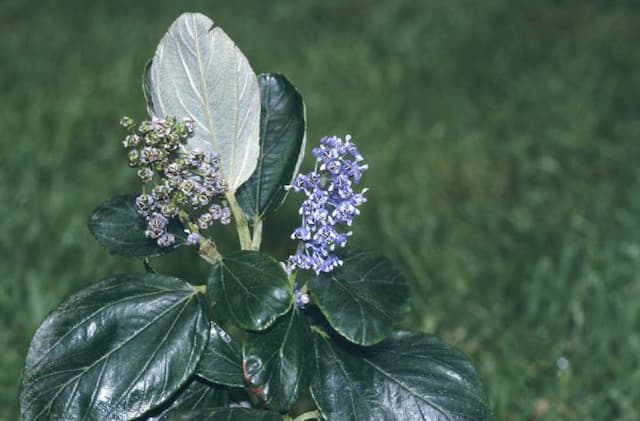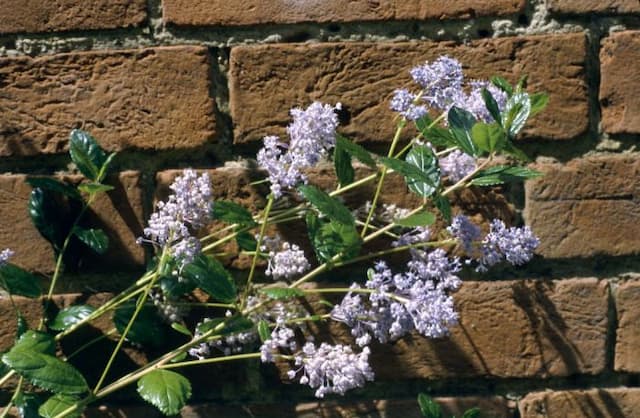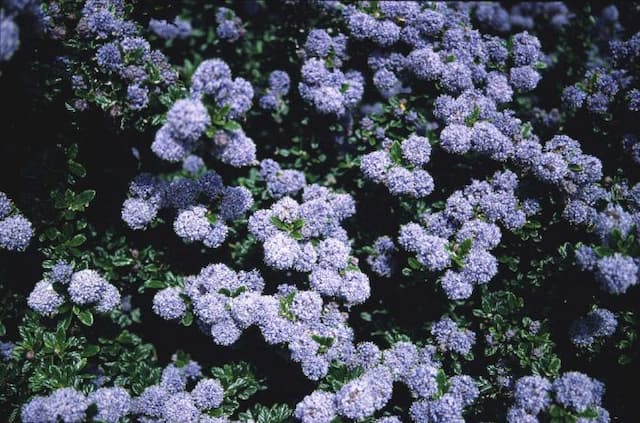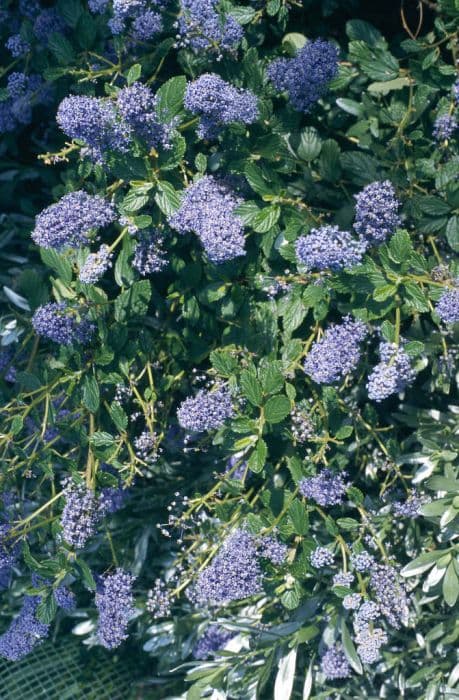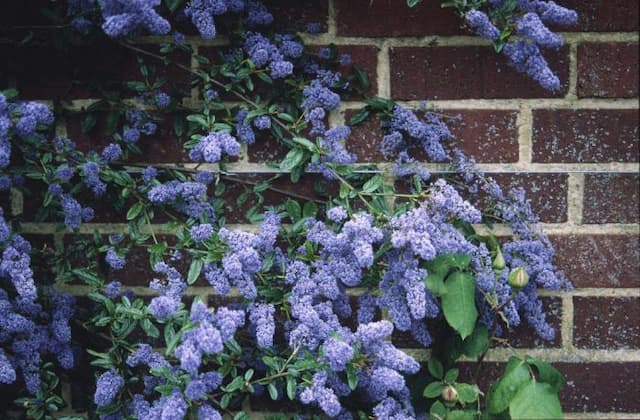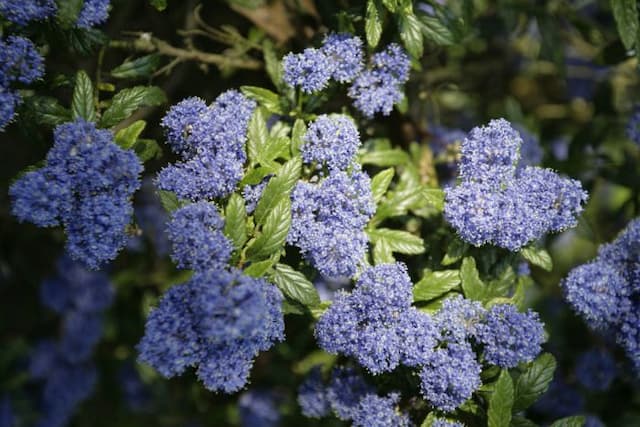California Lilac Ceanothus 'Delight'

ABOUT
Ceanothus 'Delight', also known as California lilac, showcases a stunning display with its rich, deep blue flowers that form dense clusters and create a prominent visual appeal. These clusters are comprised of tiny, individual blossoms that come together in cone-shaped panicles, offering a lush and vibrant appearance when in full bloom. The leaves of this plant add to its charm, being small, glossy, and green, which contrasts beautifully with the striking blue of the flowers. California lilac is also recognized for its sturdy, woody stems, which provide a robust framework for the plant. When not in bloom, the foliage itself carries an aesthetic quality with its intricate veining and slightly serrated margins. The texture of the leaves can be described as leathery, adding to the plant's overall hardy feel. The overall look of the California lilac is lush and evergreen in areas where it remains hardy year-round, making it a continuous source of rich, green foliage even when the blooms have faded. The plant's natural shape tends to be rounded, and it possesses a dense, bushy appearance that can make it a standout feature in any landscape where color and texture are desired.
About this plant
 Names
NamesFamily
Rhamnaceae
Synonyms
California Lilac, Blueblossom, Wild Lilac
Common names
Ceanothus 'Delight'.
 Toxicity
ToxicityTo humans
Ceanothus 'Delight', commonly known as California lilac, is not known to be toxic to humans. There are no well-documented cases of poisoning from ingesting parts of this plant. However, as with any plant, individual allergies or sensitivities can occur, so ingesting plant material is generally not advisable.
To pets
California lilac is not considered toxic to pets either. There's no significant evidence that ingesting this plant causes poisoning in pets. However, consumption of any non-food plant material can potentially cause mild stomach upset, so it is always best to prevent pets from eating plants not meant for consumption.
 Characteristics
CharacteristicsLife cycle
Perennials
Foliage type
Evergreen
Color of leaves
Green
Flower color
Blue
Height
6 feet (1.83 meters)
Spread
10 feet (3.05 meters)
Plant type
Shrub
Hardiness zones
7
Native area
North America
Benefits
 General Benefits
General Benefits- Attracts Pollinators - Ceanothus 'Delight', commonly known as California Lilac, draws bees, butterflies, and other beneficial insects to the garden, supporting local ecosystems.
- Drought Tolerance - Once established, California Lilac is highly tolerant of drought, making it ideal for water-wise landscapes and xeriscaping.
- Low Maintenance - It requires minimal care beyond the initial establishment phase, thus reducing the need for constant gardening attention.
- Erosion Control - The plant's extensive root system helps stabilize slopes and hillsides, preventing soil erosion.
- Ornamental Value - California Lilac features vibrant blue flowers and attractive evergreen foliage, adding aesthetic appeal to garden spaces.
- Wildlife Habitat - It provides shelter and food for various wildlife species, promoting biodiversity in the garden.
- Fast Growth - As a fast-growing plant, California Lilac quickly establishes itself and fills in garden areas, providing a lush look in a relatively short time.
- Habitat Restoration - The plant is native to North America, and using it in the landscape helps restore natural plant communities.
- Year-Round Interest - With evergreen foliage and seasonal blooms, it offers visual interest throughout the year.
 Medical Properties
Medical PropertiesThis plant is not used for medical purposes.
 Air-purifying Qualities
Air-purifying QualitiesThis plant is not specifically known for air purifying qualities.
 Other Uses
Other Uses- Low Maintenance Hedge: California lilac can be used to create a vibrant, low maintenance hedge that provides privacy and adds a splash of color without the need for frequent trimming.
- Natural Pesticide: The plant can act as a natural pest deterrent in gardens due to its foliage scent and properties.
- Erosion Control: Its extensive root system makes it an excellent choice for stabilization and erosion control on slopes and banks.
- Livestock Fodder: In some rural settings, California lilac may be used as an emergency fodder for livestock, though it's not a common feed source.
- Dye Production: Historically, some species of Ceanothus have been used to produce a green dye from the flowers; California lilac could potentially be used in a similar manner.
- Garden Sculpting: This adaptable shrub can be pruned into various shapes for creative garden sculpting endeavors.
- Support for Beneficial Insects: California lilac attracts beneficial insects like bees, butterflies, and other pollinators, supporting the overall health of a garden ecosystem.
- Nitrogen Fixation: The plant has the ability to fix nitrogen in the soil, improving soil fertility for other plants in the vicinity.
- Culinary Experiments: Although not commonly used for culinary purposes, the flowers of California lilac are edible and have potential for use in experimental kitchen endeavors such as infusing desserts or making syrup.
- Photography Subject: The vibrant blue blossoms make California lilac a favorite subject for garden photographers and nature enthusiasts.
Interesting Facts
 Feng Shui
Feng ShuiCalifornia lilac is not used in Feng Shui practice.
 Zodiac Sign Compitability
Zodiac Sign CompitabilityCalifornia lilac is not used in astrology practice.
 Plant Symbolism
Plant Symbolism- Hardiness: Ceanothus, commonly known as California lilac, is known for its robust nature, symbolizing the ability to withstand challenging conditions and maintain perseverance.
- Renewal: With its vibrant blue flowers that bloom in the spring, the California lilac signifies new beginnings and rejuvenation.
- Attraction: The plant's profuse blue blossoms are not only visually appealing but also attract beneficial insects, making it symbolic of magnetism and allure.
- Inspiration: The striking blue of the California lilac flowers can symbolize inspiration and a spur to creativity due to its unusual and eye-catching hue.
 Water
WaterCalifornian Lilac prefers moderate watering and well-draining soil to prevent root rot. It should be watered thoroughly, allowing the water to penetrate deep into the soil, which encourages deep root growth. In the absence of rainfall, water the plant every 7 to 10 days, providing approximately 1-2 gallons of water each time during the growing season. During the dormant season in winter, reduce watering to every 3 to 4 weeks if there's no significant rainfall, ensuring the soil doesn't completely dry out.
 Light
LightCalifornian Lilac thrives best in full sunlight. To ensure the plant gets the optimal light for flowering and growth, plant it in a spot where it will receive direct sunlight for at least 6 hours a day. Californian Lilac can tolerate partial shade, but its blooms might not be as prolific.
 Temperature
TemperatureCalifornian Lilac can tolerate a wide range of temperatures but prefers a climate with warm summers and mild winters. It is hardy in temperatures as low as 10°F and can handle heat up to about 100°F, although it thrives best between 60°F and 80°F. Avoid planting in locations where temperatures dip below 10°F for extended periods.
 Pruning
PruningCalifornian Lilac should be pruned to maintain shape and encourage bushy growth. Prune right after the flowering season ends to avoid cutting off next year's buds. Pruning once a year is sufficient for this plant. The best time for pruning is in the late spring or early summer, immediately after it finishes blooming.
 Cleaning
CleaningNot needed
 Soil
SoilThe California lilac 'Delight' prefers a well-draining soil mix with low to moderate fertility. It thrives in soil pH ranging from slightly acidic to slightly alkaline (pH 6.0-8.0). A mix of loam, sand, and compost is ideal to ensure good drainage and aeration.
 Repotting
RepottingThe California lilac 'Delight' does not need frequent repotting; it can be repotted every 2-3 years or when the root system outgrows the current container. Care should be taken not to damage the sensitive roots during repotting.
 Humidity & Misting
Humidity & MistingCalifornia lilac 'Delight' is tolerant of a range of humidity levels but prefers moderate humidity. It does well in the average humidity found in most outdoor environments without the need for additional humidity adjustments.
 Suitable locations
Suitable locationsIndoor
Ensure bright light, well-draining soil, minimal watering.
Outdoor
Plant in full sun, well-drained soil, protect from strong winds.
Hardiness zone
7-10 USDA
 Life cycle
Life cycleCeanothus 'Delight', commonly known as California lilac, begins its life cycle when seeds germinate, typically after exposure to heat or wildfire which cracks the tough seed coat. Seedlings emerge and enter a growth phase, developing a deep root system and producing characteristic glossy green leaves. The plant matures and enters a reproductive stage, flowering in the late spring to early summer—blooms are dense clusters of tiny, blue or purple flowers, which attract pollinators. After pollination, seeds form and are dispersed, often requiring another fire cycle or manual intervention to germinate successfully. Mature plants can live for about 10-25 years, although they may have shorter lifespans in garden settings. Throughout its life, California lilac may undergo periods of dormancy, particularly in hot, dry summers or cold winters, resuming growth as conditions become favorable.
 Propogation
PropogationPropogation time
Spring to early summer
The most popular method of propagating Ceanothus 'Delight', also known as California lilac, is from semi-ripe cuttings taken in late summer. To do this, a healthy, semi-woody shoot is selected and a segment around 4 to 6 inches (10 to 15 centimeters) long is cut just below a leaf node. The lower leaves are removed, and the cut end may be dipped in rooting hormone to encourage root growth. The cutting is then inserted into a pot filled with a mix of peat and perlite, ensuring that several nodes where leaves were removed are buried in the medium. The pot should be placed in a warm, bright area but out of direct sunlight and kept moist until roots develop, usually within a few weeks. Covering the pot with a plastic bag can help maintain high humidity levels, which is crucial for rooting. After the cuttings have rooted and start showing new growth, they can be transplanted into individual pots to grow on before being planted out.
